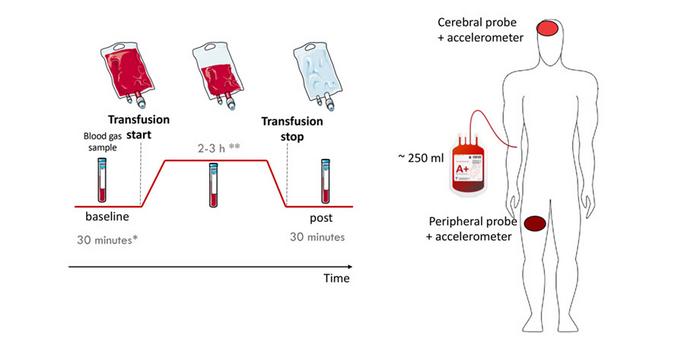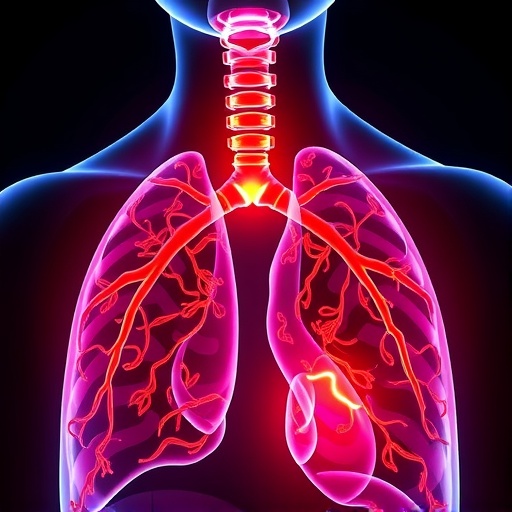Red blood cell transfusions (RBCTs) are vital for patients who suffer from conditions such as severe anemia, which can arise from various medical issues including surgery, trauma, or chronic diseases. The challenge in administering these lifesaving treatments lies not only in the transfusion itself but also in understanding how these procedures affect the recipient’s body. In recent years, researchers have begun to explore innovative monitoring technologies that can efficiently evaluate the systemic and localized changes occurring during and after RBCTs, leading to potentially enhanced patient outcomes.
A pioneering study reported in the journal Biophotonics Discovery highlights the advantages of hybrid diffuse optics (DO), a cutting-edge technology that employs near-infrared light to continuously monitor blood flow and oxygen saturation. This noninvasive approach represents a significant departure from conventional methods, offering clinicians the ability to observe real-time changes in tissue oxygenation in critically ill patients receiving transfusions, without the need for invasive procedures that carry their own risks.
The importance of monitoring blood flow and oxygen levels becomes evident when considering the complexities of critical care. During RBCTs, the reintroduction of red blood cells can shift hemodynamics in unpredictable ways, affecting not only the efficacy of the transfusion but also the overall oxygen delivery to vital organs. Preliminary results from the study show that hybrid DO can provide comprehensive data regarding peripheral and cerebral blood flow, which may aid in optimizing transfusion strategies tailored to individual patient needs.
During the investigation, critically ill patients undergoing transfusion were monitored using optical probes affixed to their foreheads and muscle areas. These probes continuously collected data regarding blood oxygenation levels before, during, and after the transfusion process. Remarkably, findings indicated that both the brain and muscle oxygen supply increased significantly post-transfusion. This elevation was verified by observing increased levels of oxygenated hemoglobin, illustrating how crucial this technology can be in assessing transfusion effects.
Interestingly, the study revealed that while the brain maintained stable perfusion rates, the muscles exhibited marked increases in blood flow. This suggests the presence of protective physiological mechanisms in the brain, which may prioritize oxygen delivery and prevent potential complications such as over-perfusion. By employing hybrid DO technologies, clinicians are provided with insights that can influence transfusion protocols and decision-making in real-time, reducing the incidence of adverse events linked to inefficient oxygen distribution.
The insights gleaned from this study are propelling a movement towards personalized medicine in the context of blood transfusions. With the capability to monitor specific tissues closely, practitioners can design more effective transfusion plans that address individual patient profiles while mitigating risks associated with excessive or inadequate blood flow. This level of precision in monitoring not only enhances patient outcomes but also has the potential to foster greater confidence in clinical decision-making.
In addition to improving transfusion strategies in critically ill patients, the applications of hybrid diffuse optics may extend into various areas of healthcare. Surgeries that necessitate blood transfusions, neonatal care where precise oxygen delivery is critical, and neurocritical care could all benefit from this advanced monitoring technology. Moreover, chronic conditions that lead to continuous requirement of blood products may also see improved management through tailored transfusion strategies guided by real-time monitoring.
The study’s outcomes stress the potential of moving towards wider adoption of noninvasive technologies in clinical practice. By transitioning from traditional, invasive monitoring techniques, healthcare providers can foster an environment of safer, more effective patient care. This advancement marks a significant innovation in critical care, where the pressure to save lives is coupled with the need to understand profoundly how interventions, like blood transfusions, affect the body’s complex physiology.
As the medical community continues to absorb the findings from this research, the integration of hybrid diffuse optics into regular clinical workflows could become a cornerstone in transfusion medicine. With compelling evidence backing the technology’s reliability and usefulness, one can envision a future where every blood transfusion is accompanied by precise, real-time data indicating the patient’s response, thereby advancing the field substantially.
Such innovations are vital not only in saving lives but also in enhancing the quality of care provided to individuals in vulnerable health situations. Optimal oxygen delivery is crucial in ensuring that patients recover effectively and with minimal complications, paving the way for more advanced treatments based on sound physiological principles. By meticulously understanding and monitoring physiological responses, medical professionals can act with heightened awareness and effectiveness.
In conclusion, the exploration of advanced monitoring technologies like hybrid diffuse optics is set to redefine the landscape of blood transfusion practices. Through better understanding and real-time data, healthcare providers can address the nuances of each patient’s condition with a finer degree of care. This pioneering approach opens the door to improved outcomes in transfusion medicine, embodying the principles of personalized healthcare where treatment is precisely tailored to each individual’s needs. As further research unfolds, the potential impact of this technology could be monumental, paving the way for safer, more effective approaches in critical care.
Subject of Research: People
Article Title: Hybrid diffuse optical appraisal of peripheral and cerebral changes in critically ill patients receiving red blood cell transfusion
News Publication Date: 23-Jan-2025
Web References: Journal Article
References: S. Tagliabue et al., “Hybrid diffuse optical appraisal of peripheral and cerebral changes in critically ill patients receiving red blood cell transfusion,” Biophotonics Discovery 2(1), 015001 (2025), doi: 10.1117/1.BIOS.2.1.015001
Image Credits: S. Tagliabue et al., doi 10.1117/1.BIOS.2.1.015001
Keywords: Blood transfusion, Blood flow, Human brain, Muscles, Clinical research, Brain tissue, Muscle tissue.
Tags: advancements in critical care monitoringbiophotonics in medicineblood transfusion monitoringcritical care innovationsdiffuse optics technologyhemodynamic changes during transfusionnear-infrared light applicationsnoninvasive blood monitoringpatient outcomes in transfusion therapyred blood cell transfusionssystemic changes after transfusiontissue oxygenation assessment





